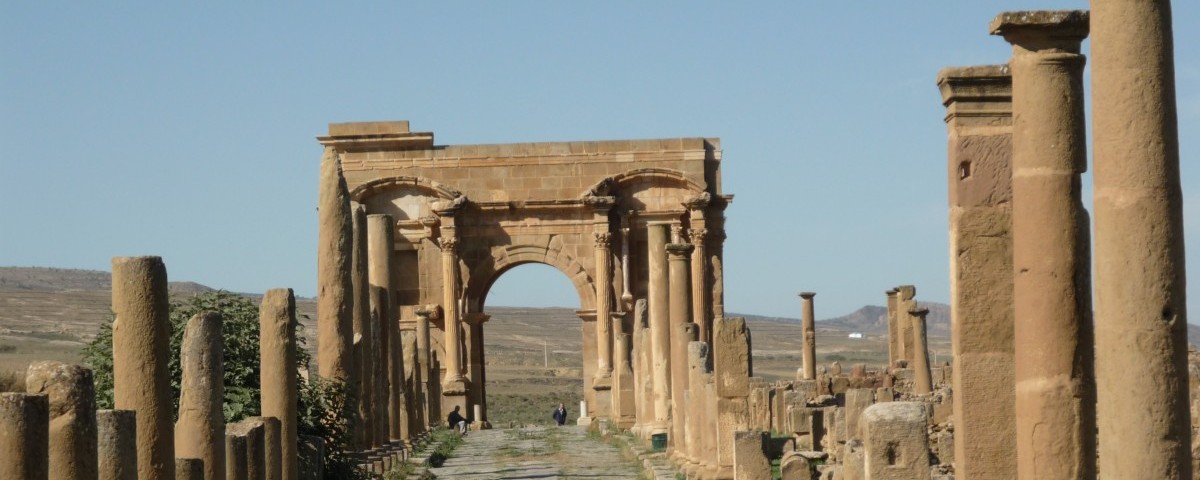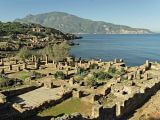Algeria Roman Empire

Description
Roman EMPIRE had established about 500 settlements throughout North Africa, and the Berber territory, local Berber populations fell in the Roman region of Numidie and in the west in Mauritania . . With its fertile farmland, this part of North Africa was known as "the granary of the empire". those site's Classified by UNESCO World Heritage , we find the sites of Djemila , Timgad and Tipaza . These are considered among the best in the ancient world, in addition to many other sites. The beautifully complete ruins of Djemila and Timgad are very popular destinations. These are best-preserved cities out of the six hundred that stood proudly across the breadth of Roman North Africa.
PROGRAM
Algiers tipaza tour

Departure towards Cherchell, ancient Roman Caesarea (Phoenician IOL). Then visit the Museum of Outstanding Ancient Sculptures the Museum of Ancient Pieces and the Mosaic Garden and we will end with a discovery of Roman baths.
Tipaza direction and visit the ancient city located on the West Hill, the theater, the circus, the thermal baths ... (This site is classified by UNESCO Heritage of Humanity) ... Many Punic vestiges, Roman, Christians and Africans attest to the rich history of this region.
On the way back, we visit the royal mausoleum of Mauritania, called Christian tomb, called Tomb of the Christian. Dinner and overnight at the hotel.
Algiers city tour

Departure to visit the Casbah; starting with the Citadel and the Centennial House (Architect Claro Léon) then cross the Kasbah through narrow streets while stopping to visit traditional houses, terraces with panoramic views of the Bay of Algiers, tea tastings and traditional cakes.
Then visit the oldest mosque of the Casbah: Sidi Ramdane, the Bir Chebana Fountain, the Mausoleum Sidi Abderahmane, Mustapha Pasha Palace (currently Arab Calligraphy Museum). Traditional lunch at the Kasbah.
Afternoon we discover the waterfront boulevard and the National Theater (1853), the famous district of Bab El Oued is a collection of neighborhoods (Guillemin, Three Clocks, Baceta, Climate of France and Trioli) and we finish the hike by the basilica of our Lady of Africa (1872) an architectural jewel built on an exceptional site that dominates Algiers from the East to the West. Dinner and overnight at the hotel.
Djemila & setif

Departure a little early to the archaeological park "Djemila", classified by UNESCO Heritage of Humanity. Formerly Cuicul. It is one of the most beautiful Roman ruins in the world. The archaeological remains, the well-integrated Roman urban plan and the environmental setting are the resources that represent the values attributed to the site (we discover the Arc de Caracala, the Grandes Thermes, the Christian Basilica and the museum and its magnificent paintings mosaics) as well as the Baptistery of the 4th Century.
Destination now Setif, check in at the hotel, then walk through the city and its wide streets for shopping and its famous fountain "Ain El Fouara", symbol of the city. Dinner and overnight at the hotel.
Constantine

Departure to Tiddis: an authentic Berber site modified by the Roman civilization and arranged according to their urbanization systems. Tiddis (or Castellum Tidditanorum), which once depended on Cirta still retains Libyan inscriptions and symbols on the Berber pottery. Constantine direction, chek in the hotel, then have lunch.
Afternoon, visit the Cirta Museum, then walk through the alleys of the old town, which is a real incursion into the history of Constantine, the Rhummel gorge and the magnificent panoramas offered by the old War Memorial and the famous suspension bridges of the city. Dinner and overnight.
Timgad & Lambèse

Departure to Batna with a stop in the Salines (big Chott where salt is produced). Visit their production workshop. Then visit Medracen which is a famous Berber Tomb. Lunch in Timgad, Afternoon visit to the City of Timgad: The Roman city, which bore the name of Thamugadi (Colonia Marciana Traiana Thamugadi) in ancient times, was founded by Emperor Trajan and endowed with the status of colony. This is the last deduction colony in Africa Roman. Built with temples, baths, forum and large theater.
On the way back to the hotel, we will make a brief visit of what remains of Lambèse (Lambaesis), Heart of the Roman military presence in Africa and former headquarters of the 3rd legion of Augustus under Trajan. The small town of Tazoult is also known for its penitentiary erected in 1850 which greatly helped in the discovery of the ancient city but also a major obstacle to a thorough study of its remains, the gradual destruction because of the penitentiary, the colonial village then the current agglomeration made it difficult to conservation of the Lambèse site. Back to the hotel dinner and overnight hotel.
Madauros

Road to M'Daourouche, (Madauros), old Numidian Syphax city of the 3rd century BC. J.C. and Kingdom of Massinissa, it was then erected into an important Roman colony between the year 69 and 75 BC, under the Emperor Vespasian. St. Augustine studied there until he was 15 years old. Visit of the ancient city. Picnic lunch.
Afternoon, direction Khamissa ancient ancient city of Thubursicu Numidarum Over the centuries, it grows north and northwest to form a town of 65 hectares.
Thubursicu Numidarum, strategically, occupied a prominent place: it was located on a road connecting the port of Hippo Regius (near Annaba) to Theveste (Tebessa), camp of the Legion of Africa. in 1877 and from 1903 to 1905, in this city of the Numidae tribe, allowed to exhume: the Platea vetus (the old place), the Forum novum, a theater, thermal baths, monumental gates, funerary monuments with many epitaphs, a Byzantine chapel, measuring tables and statues of deities and notables. Continuation to Guelma, Dinner and overnight at the hotel.
Ancient Calama

After breakfast, visit and discover the ancient city of Galama. The Roman Theater, built in 201. It is based on a base of embankment dressed stone. It is due to the awakening (beneficence) of a certain Annia Aelia Restituta, daughter of a rich and powerful family of the time, she spent a fortune for the pleasure of her fellow citizens. It was rebuilt between 1902 and 1918. The theater also houses the Roman Museum of the city of Guelma, which contains important collections of coins, bronzes and statues.
Lunch on site, we will then go to Hammam Chellala or Debagh, or again (Meshutin according to the legend). The water temperature of Hammam Meshutin is exceeded at the planetary level only by the geysers of Iceland. Its therapeutic virtues were appreciated by the Romans who called this place Aqua Tibatanae. Possibility to take a bath for those who wish.
Then direction Annaba, installation at the hotel and walking tour of the city, dinner and overnight.
ANNABA

Towards the site of Hippo Regius (or Hippo) which was at first a Carthaginian colony, then the residence of the Numidian kings and Roman municipality under Augustus. It will then be occupied by the Vandals and Byzantines and finally by the Arabs in the tenth century, until the end of the Fatimid period. The city was bishop Saint Augustine from 396 to 430 AD.
Hippo, episcopal seat of Augustine. Visit of the Basilica of the Peace of Hippo, the baptistery, the theater, the forum, the baths and the Museum, then the modern Basilica of Saint Augustine with its AraboMauresque but also Byzantine and Roman style.
Lunch then Ras El Hamra (Cape Garda), the tip of the Corniche Annaba. Then direction Séraïdi Mountain to visit the hotel complex of the French architect Fernand Pouillon. End of course special dinner on site and overnight at the hotel.

